We Compare 21'-23' Center Consoles: Six Boats For Fishing Plus More
Manufacturers target most center consoles at anglers, and CCs make excellent fishing boats: There's room on either side of the helm for working a fish, the open bow area can be an efficient casting platform, and the aft cockpit provides space for built-in fishboxes, bait wells, tackle lockers and so forth. The first CCs were essentially open boats with a helm console in the middle and lots of rod holders; today, the typical center console is much more than that.
But center consoles, including the boats in this roundup, can be set up for more than just fishing: They make great tenders for snorkeling or scuba diving, they're good for towing skiers or wakeboarders, and are excellent for "messing about in boats." About all they can't be modified for is serious sunbathing and lounging, or serving as floating patios -- for that, choose a bowrider or pontoon.
Any of these six boats will do the trick when it comes to having fun on the water. They are all from first-class builders, carry state-of-the-art outboard engines, and come with lots of standard equipment. Deciding which is most suitable will take research. Reading our Captain's Reports is a good first step: You'll find full info on each one, along with performance figures if we've had a chance to test the boat. Please contact BoatTEST.com if you have further questions.
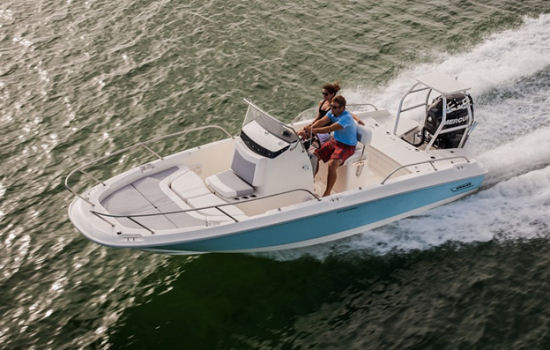
Boston Whaler's 210 Dauntless is a good choice for folks who sometimes will be going in harm's way in their boats, since one can fill a Whaler nearly to the gunwales and often keep on going, letting the water run out the transom drain. (At least one of us here at BoatTEST can attest to this.)
Boston Whaler builds the 210 Dauntless using a different construction method -- the company calls it Unibond -- than any other boat builder, but one that's been keeping Whalers unsinkable and nearly indestructible for more than half a century. The hull and deck are molded separately and joined while still in their molds, then foam is injected at high pressure into the cavity between them. Unibond makes the boat strong, stiff and unsinkable -- it's what makes a Whaler, a Whaler.
Besides her foam-injected structure, the 210 Dauntless comes with a long list of standard equipment, including dual batteries, hydraulic steering, a portable toilet in the console, and a bow rail to keep anglers aboard when casting in choppy water. We'd add the optional T-top, both for shade and for a place to mount antennas and maybe a radar. And we also like the unusual Activity Tower, a combination poling platform, wakeboard tower, tow point, and conveniently high handhold for folks on the swim platforms. There are also a couple more rod holders here.
Standard power for the 210 Dauntless is a 150-hp Mercury four-stroke outboard, but we'd upgrade to the 200-hp Mercury. With this power, our test boat ran 40.2 kts. max, cruised at 23.2 with a 263-n.m. range, enough to run offshore chasing fish, or run around the bay having fun for the whole weekend.
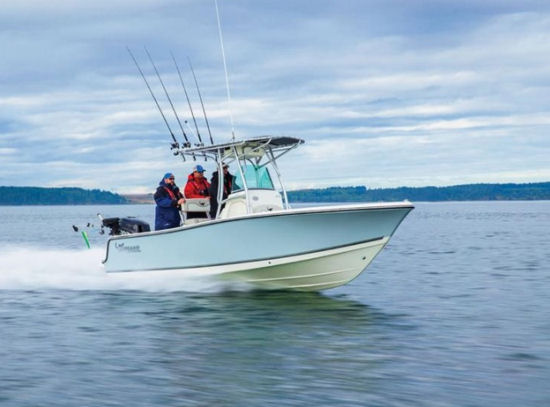
The Mako 214 CC has, in our opinion, the most graceful lines of any boat in this roundup, with a slightly S-curved sheerline (designers call this a "powderhorn" sheer, although powderhorn sheers are usually curvier than this one), a reverse transom that leads into a minimal stern platform, and a no-tricks V-bottom whose forward sections wouldn't look out of place with shark's teeth painted on. Stick an arsenal of rods in the rocket launcher on the standard T-top, and the Make 214 CC shouts, "Fish beware!"
The 214 CC isn't just pretty gelcoat, though. Her 100% composite hull is supported by a one-piece foam-filled stringer grid and a 2"-thick composite transom. Hull and deck are chemically and mechanically bonded; Mako covers the boat with a limited lifetime hull warranty. All hardware is marine-grade stainless steel.
The Mako carries a bit less deadrise than the "classic" deep-V -- 18 degrees vs. 24. The deep-V was designed for racing in rough water, and the sharper deadrise makes the best compromise between speed and seakeeping. The slightly shallower after sections of the Mako add stability at rest (not a concern for raceboats) and maybe a bit of speed vs. hp, too: Flatter sections add speed, but pound harder when wave-jumping. We haven't tested the 214 CC, but independent tests suggest a top speed of around 41 kts. with a 250-hp Mercury Verado outboard. A 150-hp Mercury FourStroke is standard, and the middle power option, a 200-hp Verado, should be enough for most people.
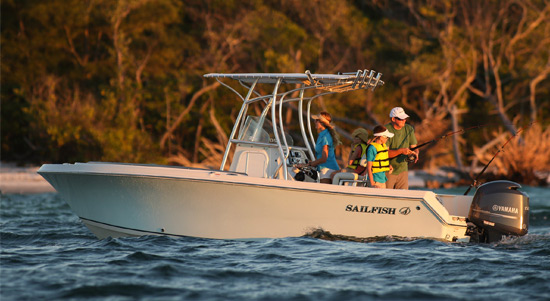
The Sailfish 220 CC is, in one way, three boats in one -- or at least one boat with three bottoms. Rather than choosing a deadrise angle for speed, or comfort, or stability, Sailfish opted to combine all three in what they call the VDS (Variable Deadrise Stepped) Hull. At the keel, the deadrise is 24 degrees; halfway to the chines, 23 degrees; at the chines, 22 degrees.
At high speed, the boat rides on the sharper sections along the centerline; when drift-fishing, the flatter outer sections increase stability compared to a straight 24-degree hull. The chines are reversed to add lift, and extra bow flare and longitudinal rails keep the crew dry when running fast in a chop.
Sailfish offers Yamaha or Mercury outboards, 150- or 200-hp. We haven't tested the boat, but Sailfish's published performance sheets show a top speed of 35.7 kts. with a 150 Yamaha, 38.6 with the 200 Yamaha. Upgrading to the bigger Yamaha adds $6,905 to the price, according to the Sailfish website. (Base price is $54,651.)
The standard Sailfish 220 CC comes with a lot of equipment, including hydraulic steering, a walk-in console with port light, a freshwater shower at the transom, raw water washdown, cockpit bolsters, a baitwell and tackle stowage. Helm and companion pedestal seats are standard, rather than a leaning post -- one is optional, with rod holders and a removable backrest. A retractable ski-tow is optional (man does not live by fishing alone), along with an Entertainment Package that includes a bow table, satellite radio and underwater lights. A Comfort Package adds jump seats aft and more cushions. A T-top is also optional.
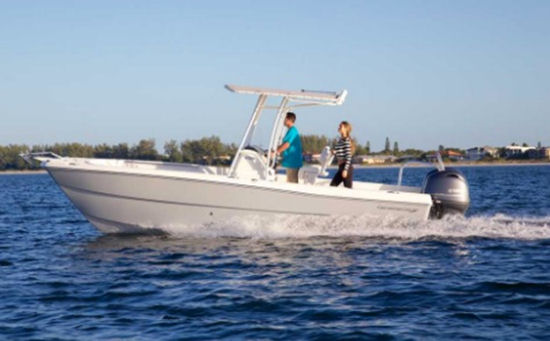
The World Cat 230CC (formerly the Carolina Cat 23CC -- same boat, different name) is, as her name suggests, a catamaran. Cats have advantages over deep-Vs in some areas. According to our test captain, the World Cat 230CC's narrow hulls slice through chop without pounding, even at wide-open throttle. A single hull this narrow would roll like a drunken sailor, if it even stayed upright, but the World Cat's two hulls provide plenty of stability.
World Cat calls their twin-hull arrangement the VectorFlo hull, and it's more than just two narrow boats tied together. The space between the hulls is as important as the hulls themselves: The tunnel is narrower aft than forward, so the mixture of air and water compresses and accelerates as it moves aft. This reduces drag and creates a water "cushion" that improves stability, efficiency and comfort.
Two hulls usually mean two engines, an advantage to folks still not convinced of the reliability of outboards. But engines most often fail due to electrical or fuel issues, and if gunky fuel kills one motor, it kills the other one, too, if they pull from the same tank. World Cat gives each engine an independent electrical and fuel system, creating a redundancy not found on many twin-engine boats. While bad gas from the marina pump usually ends up in both tanks, separate systems can improve the odds, a big plus for anglers who want to fish offshore.
With twin 115-hp Yamaha four-strokes, the 230CC we tested ran 38.8 kts., cruised at just 16.5 kts., but produced 295 n.m. of range at that speed. Folks wanting to get there a bit faster could throttle up to 21 kts. at a fuel-burn penalty of just .1 nmpg.
Thin-water boaters will like the 230CC's 9" motor-up draft, thanks to her flat planing pads at the transom. What's better for beach excursions than draft of under a foot? An aluminum swim platform and a swim ladder are both optional.

The Robalo R222 ES shows that the company is serious about combining fish-ability with family amenities. Along with the usual angling gear -- rod racks, an overboard-draining fishbox, a live well, under-gunwale rod stowage, raw-water washdown -- Robalo also includes a premium sound system, seat cushions with removable backrests in the bow, a three-step boarding ladder, and a Porta-Potti in the console. Add the optional cockpit table and bow filler cushion, and the 222 ES center console takes on some bowrider characteristics. She is a boat the whole family can enjoy.
Like the Sailfish 220 CC, the Robalo 222 ES rides on a variable-deadrise hull, in this case the company's proprietary design, the HydroLift hull. It's similar to, but not the same as, Sailfish's VDS hull. The HydroLift has extended running surfaces that carry beyond the transom and under the swim platform. Robalo says the HydroLift combines stability at rest with efficiency at speed, while producing quick acceleration and "maximum fuel efficiency."
Robalo builds the 222 ES, like they do all their boats, using hand-laid fiberglass fabrics in vinylester resin, further reinforced with Kevlar in critical areas; Kevlar is stronger and lighter than fiberglass. The transom is cored with a poured ceramic composite that is strong, stiff and rot-proof; the boat is 100% rot-proof. Closed-cell foam provides flotation. Robalo chooses gelcoats with maximum resistance to fading and chalking, so with minimal care a new 222 ES should keep looking that way for many seasons.
Engine options include Evinrude, Mercury and Yamaha, from 150 to 250 hp. With a 200-hp Yamaha four-stroke, our test boat ran 37.7 kts., cruised at 18.6 with 287 n.m. of range.
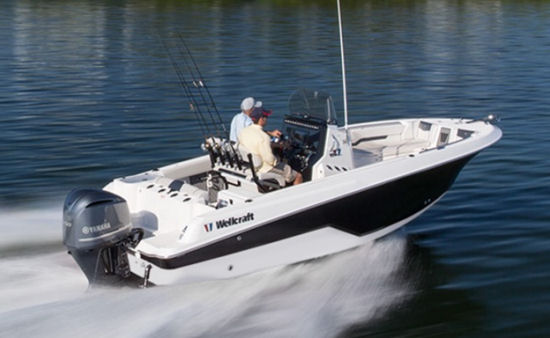
Wellcraft's 222 Fisherman comes in two versions, regular and "high-test": The Scarab Offshore Package adds tri-tone topsides colors, done in gelcoat; custom graphics; and an upgraded leaning post, cockpit, and helm. Wellcraft built Scarab high-performance boats (remember Miami Vice?), and some of that mojo has worked its way into the 222 Fisherman Scarab Offshore, at least on the surface. Otherwise, the two versions are the same: Same specs, same engine choices, etc.
Wellcraft combined 60 years of boatbuilding experience with 21st-century computer-aided design to create the 222 Fisherman. She carries the most fuel of the six boats, enough for almost 300 n.m. of cruising range (296.6, to be exact). That's what our test boat, powered by a Yamaha F250 outboard, produced at exactly 20 kts. Cranked wide-open, the Fisherman hit 42 kts.
The F250 is one of eleven engines Wellcraft offers with the 222F, from Evinrude, Mercury and Yamaha. The smallest is a 115-hp Yamaha, but we suggest a few more horses than that. We'd look closely at the Evinrude E-TEC 250, probably a bit noisier than the four-stroke Yamaha, but nearly as fuel-efficient and requiring less maintenance. Trim tabs are optional, but we'd recommend them, especially with the bigger OBs.
Along with the usual fishing gear, Wellcraft installs a Porta-Potti as standard, along with dual batteries and a raw-water washdown. An electric toilet is optional. Also optional is a Family Package that improves the seating and adds a bow table, an upgrade family members will appreciate. There are two T-tops available, as well as a Bimini; several stereo packages; bow rails; underwater lights; and a GPS/plotter.
Again, don’t hesitate to drop BoatTEST.com a note if you have a question about any of these boats.
Boston Whaler 210 Dauntless


- LOA: 21'3" (6.48 m)/li>
- Beam: 8'6" (2.59 m)
- Draft: 14" (.36 m)
- Displacement: 3,616 lbs. (1,640 kg) w/engine
- Deadrise at Transom: 16-degrees
- Fuel Capacity: 75 gal. (284 L)
- Maximum Power: 200-hp
Mako 214 CC

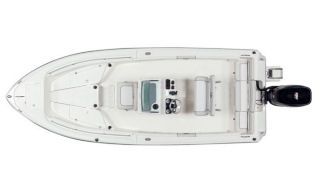
- LOA: 21'5" (6.53 m)
- Beam: 8'6" (2.59 m)
- Draft: 15" (.38 m)
- Displacement: 3,735 lbs. (1,694 kg) w/engine
- Deadrise at Transom: 18-degrees
- Fuel Capacity: 91 gal. (414 L)
- Maximum Power: 250-hp
Sailfish 220CC

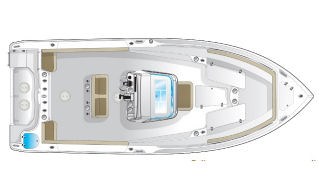
- LOA: 21'3" (6.48 m)
- Beam: 8'6'' (2.59 m)
- Draft: 18" (.46 m)
- Displacement: 4,450 lbs. (2,018 kg) w/engine
- Deadrise at Transom: 22-24-degrees
- Fuel Capacity: 93 gal. (352 L)
- Maximum Power: 200-hp
World Cat 230CC


- LOA: 22'7" (6.88 m)
- Beam: 8'6'' (2.59 m)
- Draft: 9" (.23 m)
- Displacement: 4,000 lbs. (1,814 kg)
- Deadrise at Transom:
- Fuel Capacity: 89 gal. (337 L)
- Maximum Power: 2 x 115-hp
Robalo R222 ES

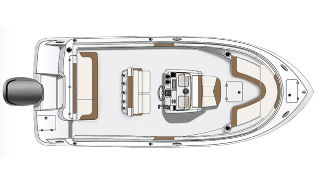
- LOA: 21'6" (6.55 m)
- Beam: 8'6" (2.59 m)
- Draft: 18" (.46 m)
- Displacement: 3,700 lbs. (1,678 kg)
- Deadrise at Transom: 21-degrees
- Fuel Capacity: 90 gal. (341 L)
- Maximum Power: 250-hp
Wellcraft 222F


- LOA: 22'0" (6.71 m)
- Beam: 8'6'' (2.59 m)
- Draft: 16" (.41 m)
- Displacement: 3,600 lbs. (1,633 kg)
- Deadrise at Transom: 20-degrees
- Fuel Capacity: 103 gal. (390 L)
- Maximum Power: 250-hp